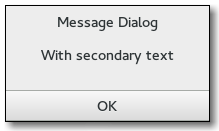Gnome::Gtk3::MessageDialog
A convenient message window

Description
Gnome::Gtk3::MessageDialog presents a dialog with some message text. It’s simply a convenience widget; you could construct the equivalent of Gnome::Gtk3::MessageDialog from Gnome::Gtk3::Dialog without too much effort, but Gnome::Gtk3::MessageDialog saves typing.
One difference from Gnome::Gtk3::Dialog is that Gnome::Gtk3::MessageDialog sets the skip-taskbar-hint property to 1, so that the dialog is hidden from the taskbar by default.
The easiest way to do a modal message dialog is to use gtk_dialog_run(), though you can also pass in the GTK_DIALOG_MODAL flag, gtk_dialog_run() automatically makes the dialog modal and waits for the user to respond to it. gtk_dialog_run() returns when any dialog button is clicked.
Gnome::Gtk3::MessageDialog as Gnome::Gtk3::Buildable
The Gnome::Gtk3::MessageDialog implementation of the Gnome::Gtk3::Buildable interface exposes the message area as an internal child with the name “message_area”.
See Also
Gnome::Gtk3::Dialog
Synopsis
Declaration
unit class Gnome::Gtk3::MessageDialog;
also is Gnome::Gtk3::Dialog;
Inheriting this class
Inheriting is done in a special way in that it needs a call from new() to get the native object created by the class you are inheriting from.
use Gnome::Gtk3::MessageDialog;
unit class MyGuiClass;
also is Gnome::Gtk3::MessageDialog;
submethod new ( |c ) {
# let the Gnome::Gtk3::MessageDialog class process the options
self.bless( :GtkMessageDialog, |c);
}
submethod BUILD ( ... ) {
...
}
Types
enum GtkButtonsType
Prebuilt sets of buttons for the dialog. If none of these choices are appropriate, simply use GTK_BUTTONS_NONE then call gtk_dialog_add_buttons().
Please note that GTK_BUTTONS_OK, GTK_BUTTONS_YES_NO and GTK_BUTTONS_OK_CANCEL are discouraged by the GNOME Human Interface Guidelines.
-
GTK_BUTTONS_NONE: no buttons at all
-
GTK_BUTTONS_OK: an OK button
-
GTK_BUTTONS_CLOSE: a Close button
-
GTK_BUTTONS_CANCEL: a Cancel button
-
GTK_BUTTONS_YES_NO: Yes and No buttons
-
GTK_BUTTONS_OK_CANCEL: OK and Cancel buttons
Methods
new
:message
Creates a new message dialog, which is a simple dialog with some text the user may want to see. When the user clicks a button a “response” signal is emitted with response IDs from Gnome::Gtk3::ResponseType. See Gnome::Gtk3::Dialog for more details.
multi method new (
Str :$message!, N-GObject :$parent?, GtkDialogFlags :$flags?,
GtkMessageType :$type?, GtkButtonsType :$buttons?
--> N-GObject
)
-
Str $message; a string. XML is converted to proper text.
-
N-GObject $parent; transient parent, or
Anyfor none -
GtkDialogFlags $flags; flags. Default is GTK_DIALOG_MODAL.
-
GtkMessageType $type; type of message. Default is GTK_MESSAGE_INFO.
-
GtkButtonsType $buttons; set of buttons to use. Default is GTK_BUTTONS_CLOSE.
:markup-message
Creates a new message dialog, which is a simple dialog with some text that is marked up with the Pango text markup language. When the user clicks a button a “response” signal is emitted with response IDs from Gnome::Gtk3::ResponseType. See Gnome::Gtk3::Dialog for more details.
multi method new (
Str :$markup-message!, N-GObject :$parent?, GtkDialogFlags :$flags?,
GtkMessageType :$type?, GtkButtonsType :$buttons?
--> N-GObject
)
-
Str $markup-message; a string with Pango markup
-
N-GObject $parent; transient parent, or
Anyfor none -
GtkDialogFlags $flags; flags. Default is GTK_DIALOG_MODAL.
-
GtkMessageType $type; type of message. Default is GTK_MESSAGE_INFO.
-
GtkButtonsType $buttons; set of buttons to use. Default is GTK_BUTTONS_CLOSE.
:native-object
Create a MessageDialog object using a native object from elsewhere. See also Gnome::N::TopLevelClassSupport.
multi method new ( N-GObject :$native-object! )
:build-id
Create a MessageDialog object using a native object returned from a builder. See also Gnome::GObject::Object.
multi method new ( Str :$build-id! )
set-markup
Sets the text of the message dialog to be $str, which is marked up with the Pango text markup language.
method set-markup ( Str $str )
- Str $str; markup string
secondary-text
Sets the secondary text of the message dialog to be $message.
method secondary-text ( Str $message )
- Str $message; a string
secondary-markup
Sets the secondary text of the message dialog to be $message, which is marked up with the Pango text markup language.
Due to an oversight, this function does not escape special XML characters like gtk_message_dialog_new_with_markup() does. Thus, if the arguments may contain special XML characters, you should call some routine to escape it.
method secondary-markup ( Str $message )
- Str $message; a message
get-message-area
Returns the message area of the dialog. This is the box where the dialog’s primary and secondary labels are packed. You can add your own extra content to that box and it will appear below those labels. See .get-content-area() described in the parent class Gnome::Gtk3::Dialog.
Returns: A Gnome::Gtk3::Box corresponding to the “message area” in the message_dialog.
method get-message-area ( --> N-GObject )
Properties
An example of using a string type property of a Gnome::Gtk3::Label object. This is just showing how to set/read a property, not that it is the best way to do it. This is because a) The class initialization often provides some options to set some of the properties and b) the classes provide many methods to modify just those properties. In the case below one can use new(:label(‘my text label’)) or gtk_label_set_text(‘my text label’).
my Gnome::Gtk3::Label $label .= new;
my Gnome::GObject::Value $gv .= new(:init(G_TYPE_STRING));
$label.g-object-get-property( 'label', $gv);
$gv.g-value-set-string('my text label');
Supported properties
Message Type
The type of the message. Widget type: GTK_TYPE_MESSAGE_TYPE
The Gnome::GObject::Value type of property message-type is G_TYPE_ENUM.
Message Buttons
The buttons shown in the message dialog Default value: False
The Gnome::GObject::Value type of property buttons is G_TYPE_ENUM.
Text
The primary text of the message dialog. If the dialog has a secondary text, this will appear as the title.
The Gnome::GObject::Value type of property text is G_TYPE_STRING.
Use Markup
1 if the primary text of the dialog includes Pango markup. See pango_parse_markup().
The Gnome::GObject::Value type of property use-markup is G_TYPE_BOOLEAN.
Secondary Text
The secondary text of the message dialog.
The Gnome::GObject::Value type of property secondary-text is G_TYPE_STRING.
Use Markup in secondary
1 if the secondary text of the dialog includes Pango markup. See pango_parse_markup().
The Gnome::GObject::Value type of property secondary-use-markup is G_TYPE_BOOLEAN.
Message area
The Gnome::Gtk3::Box that corresponds to the message area of this dialog. See gtk_message_dialog_get_message_area() for a detailed description of this area. Widget type: GTK_TYPE_WIDGET
The Gnome::GObject::Value type of property message-area is G_TYPE_OBJECT.